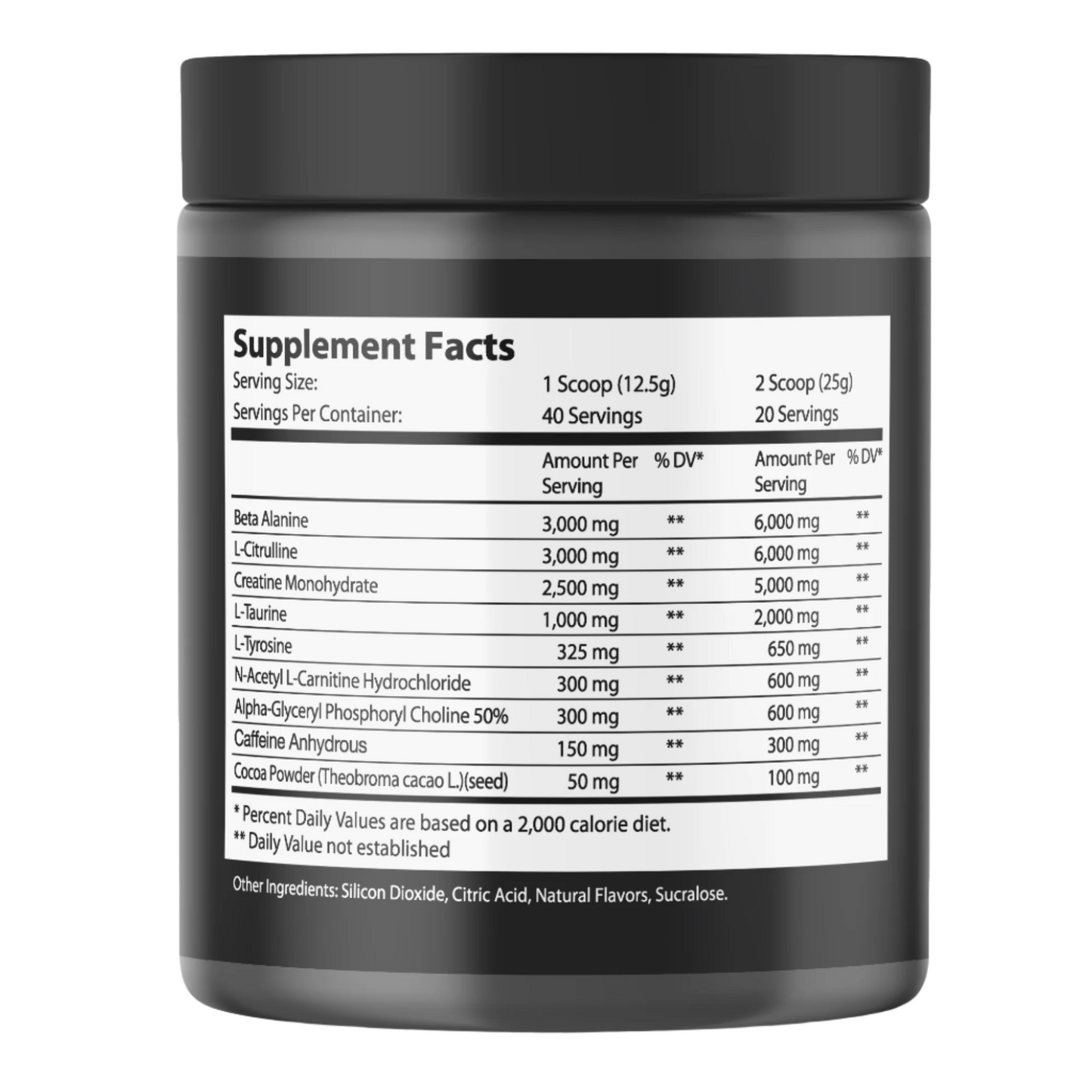
Build Muscle With German Volume Training
Share
German Volume Training is a bodybuilding program popularized by one of the greatest strength coaches of all time, Charles Poliquin. The basis of this training method relies on three principles. You can increase your muscle size if you train with higher volume, more frequency, and shorter rest periods. In this article, we will talk about muscle building with German Volume Training and provide an example workout routine for increasing mass!
Does German Volume Training Build Muscle?
There are thousands of training programs that claim to build muscle but are they backed by scientific research and real-world evidence? German Volume Training is a workout program that Olympic lifters, powerlifters, and bodybuilders have used for decades. It’s an effective way to build muscle mass quickly with the use of exercises like squats, deadlifts, bench press, and other compound lifts.
However, just because athletes and lifters use a program, doesn’t mean it is any better than another. One study found that a 10-set program (like German Volume Training) did not lead to more muscle hypertrophy than a 5-set program.
But before you throw the baby out with the bath water, keep reading to learn the specifics of GVT training and how it can help you build muscle.
Why German Volume Training Builds Muscle?
Our muscles adapt to exercise. To keep growing, the muscles need a new stimulus that requires a new adaptation. Creating a scheduled change of training styles is much more effective than using one program for a lifetime.
For most people, German Volume Training is a completely new way to train a muscle. Most bodybuilding programs suggest 3-4 sets per muscle group whereas GVT recommends 10-sets for a single exercise. Performed with high intensity, this exhausts the muscle of ATP, glycogen, and any fuel source it can use to lift the heavy weight. The muscle is literally…drained.
Who Should Use German Volume Training?
GVT is not a great way for beginners to build muscle. It’s intense, but the volume of work can be manageable as long as you have a few years of training experience under your belt. For very experienced lifters, GVT may not offer enough novelty or stimulus to get better results than more comprehensive programs. German Volume Training appears to be the best fit for an intermediate bodybuilder but it really comes down to the individual and their specific needs.
Who Should Not Use German Volume Training?
German Volume Training requires a significant amount of volume which can tax the central nervous system. This type of methodology requires that the trainee have a serious workout recovery program. Anyone who has intense professional, academic, or family life demands should find a lower volume program.
Sleep is another reason you may not want to choose this program. As it is, building muscle is already hard enough when you are not getting enough sleep. This level of volume requires sufficient rest for adequate recovery.
If you are the type of person who likes variety in your program, you may find German Volume Training to be boring. It’s kind of like when you got in trouble and your teacher told you to repeatedly write the same sentence. OK, it isn’t quite like that but you get the point.
What Equipment Will I need for German Volume Training?
Since German Volume Training primarily consists of compound lifts, you will not need specialized equipment. To execute the GVT workout you will need:
- Squat Rack with Safety Bars
- Weights
- Barbell
- Adjustable Bench
It is helpful to have:
- Dumbbells
- High and Low Cable Pulley
- Dip Bars
German Volume Training Program
The german volume program has very distinct aspects and hard rules. We must follow these principles in order to agree with the original creator’s design. The sets, rep scheme, tempo, and rest periods all make this a very grueling anaerobic strength workout. It also keeps your heart rate high where you may reach cardiovascular activity levels.
10 Sets Per Exercise
Each exercise will consist of approximately triple the amount of sets than a traditional bodybuilding routine would suggest. This creates greater than normal muscle fiber fatigue and motor unit recruitment. To maintain 10 total repetitions you would either need to start with less weight or expect to reduce the weight in the progressive sets. In this program, we will start with less weight.
10 Reps Per Set
This may be the least unfamiliar part of the program for most lifters. The 10 rep sets are within the traditionally understood hypertrophy range. Why this will feel different is because 10 sets x 10 reps = 100 reps per workout. This many reps with the same movement pattern and suggested rest period will increase lactic acid buildup and create the burn associated with higher rep sets.
60 Second rest periods
Most hypertrophy muscle building workouts suggest a rest period of 1-2 minutes. GVT workout routines will be within this range, but at the shortest potential point. Why this is more challenging is because this program focuses compound lifts. It is much easier to start your next set of lat pull downs after 60-seconds than it is to perform your next set of deadlifts. The rest interval for most compound lifts is significantly greater than isolation exercises.
A compound exercise works more than one muscle group and therefore requires more muscle fiber recruitment. Rather than pulling energy from localized muscle cells, energy gets exhausted in multiple muscles of the body.
Time Under Tension Tempo Training
Researchers have shown eccentric training to be a valid workout methodology to cause muscle fiber activation which may lead to greater muscle growth. German Volume Training was an early adopter of this concept before much of the science had surfaced.
With the GVT workout program you will perform a tempo of 4-0-1-0.
- 4-second eccentric (stretch)
- 0-second peak stretch
- 1-second positive (squeeze)
- 0-second peak contraction
This aligns with the eccentric research and what we now understand as explosive positive contractions for muscle hypertrophy.
There are some GVT programs that suggest a 2-second positive contraction. Unless you have a specific reason to use a slower positive contraction, stick with the research and use as much force as possible to lift the weight.
Note: Even with a 1-second positive contraction, your final few reps will be slower reps as your muscles find the energy to move the weight.
Total Training Volume
You can see why GVT is not for beginners after considering the 10 set per exercise, 10 reps per set, brief rest intervals, and tempo training. The total muscle fiber recruitment and the central nervous system requirements can leave a lifter sore and exhausted. If you can recover from this program, then it can lead to muscle growth. However, if you do not adapt to this training volume, you may actually see a decrease in lean muscle mass.
German Volume Training Guidelines
- You will repeat each of these workouts 3-times before moving on to the next exercise routine. This allows for physical and neurological adaptations to occur.
- You must increase muscle strength by adding weight to the 2nd and 3rd rotation. Increase the weight by approximately 5% when repeating the workout.
- For each exercise begin with 60% of your 1-rep max or the amount of weight that you can lift for approximately 20-repetitions. The weight will feel heavier as you progressively move through the sets.
German Volume Training Program
Workout Routine #1
Day 1: Chest & Back
- Barbell Bench Press: 10 sets / 10 reps (4-0-1-0)
- Chin Ups: 10 sets / 10 reps (4-0-1-0)
- Incline Dumbbell Bench Press: 3 sets / 10 reps + (3-0-1-0)
- Cable Rows with Neutral Grip: 3 sets / 10 reps + (3-0-1-0)
Day 2: Legs & Abs
- Back Squats : 10 sets / 10 reps (4-0-1-0)
- Good Mornings: 10 sets / 10 reps (4-0-1-0)
- Standing Calf Raises: 3 Sets / 10 reps + (3-0-1-0)
- Lying Leg Raises: 3 sets / 10 reps + (3-0-1-0)
Day 3: Rest & Recovery
Day 4: Arms & Shoulders
- Dips: 10 sets x 10 reps (4-0-1-0)
- Barbell Curl: 10 sets x 10 reps (4-0-1-0)
- Dumbbell Shoulder Press: 3 sets x 10 reps + (3-0-1-0)
- Front Raises: 3 sets x 10 reps + (3-0-1-0)
Day 5: Rest & Recovery
Day 6: Repeat
Workout Routine #2
Day 1: Chest & Back
- Incline Barbell Press: 10 sets x 10 reps (4-0-1-0)
- Bent Over Barbell Rows: 10 sets x 10 reps (4-0-1-0)
- Flat Bench Dumbbell Fly: 3 sets x 10 reps + (3-0-1-0)
- Face Pulls: 3 sets x 10 reps + (3-0-1-0)
Day 2: Legs & Abs
- Front Barbell Squat: 10 sets x 10 reps (4-0-1-0)
- Lying Leg Curl: 10 sets x 10 reps (4-0-1-0)
- Seated Calf Raise: 3 sets x 10 reps + (3-0-1-0)
- Hanging Leg Raise: 3 sets x 10 reps + (3-0-1-0)
Day 3: Rest & Recovery
Day 4: Arms & Shoulders
- Standing Barbell Press: 10 sets x 10 reps (4-0-1-0)
- Narrow Grip Bench Press: 10 sets x 10 reps (4-0-1-0)
- Low Cable Curl: 3 sets x 10 reps + (3-0-1-0)
- Dumbbell Hammer Curls: 3 sets x 10 reps + (3-0-1-0)
Day 5: Rest & Recovery
Day 6: Repeat
German Volume Training Nutrition
The first rule about your nutrition for GVT is that you should not be in a negative calorie state for this program. This is not the best approach for a fat loss program as your body will need plenty of calories and protein to recover from these grueling workouts. Since a GVT program may lead to 5 pounds of muscle growth, we need a surplus of calories and amino acids to help stimulate recovery.






